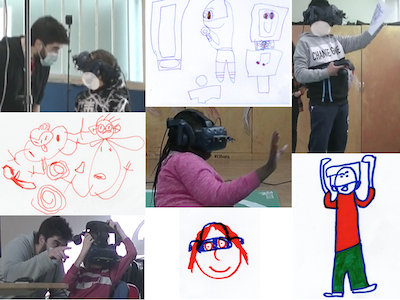This page gathers various audiovisual resources related to my PhD thesis entitled Exploring Multisensory Extended Reality Approaches for Autistic Children: Improve Well-Being and Assess Auditory Perception. This research was conducted at Université Paris Saclay, CNRS, LISN, VENISE Team between October 2019 and January 2024.
Abstract
While Extended Reality (XR) autism research, ranging from Augmented (AR) to Virtual Reality (VR), focuses on socio-emotional abilities and children with mild autism, common interventions address the entire spectrum by targeting a range of abilities, including sensory perception. Based on this observation, I conducted 34 interviews with autism stakeholders in the first part of this thesis, to compare their practical needs with the literature XR uses. Findings provided a set of XR guidelines and called for further exploring XR sensory and mediation approaches. Thus, two research endeavors were carried out within clinical settings in collaboration with practitioners. In the second part of this thesis, I investigated the use of sensory XR approaches to secure children and reinforce the child-practitioner relationship. In the third part, I focused on using AR to assess the atypical auditory functioning of autistic children. The thesis concludes by drawing research perspectives based on the main research findings.
Part 1: Extended Reality Technologies for Supporting Autism Interventions: Theory vs. Field Practices
The first part of this thesis aims at providing a whole picture of existing autism XR research while identifying research gaps. To do so, a practical state of the art was first performed, through 34 interviews conducted with autism stakeholders (mainly including practitioners). It was then compared with a theoritical state of the art, through a review of existing autism XR research in terms of use cases and designs. The most part of these studies was published in:
- Bauer, V., Bouchara, T., & Bourdot, P. (2022). Extended Reality Guidelines for Supporting Autism Interventions Based on Stakeholders’ Needs. Journal of Autism and Developmental Disorders. 34 pages. https://doi.org/10.1007/s10803-022-05447-9
Part 2: Multisensory Extended Reality Mediation Environments
Based on the findings from our interviews with autism stakeholders, the second part focuses on the design, development, and testing of several multisensory mediation XR environments intended for children with moderate to severe autism.
Magic Bubbles Augmented Reality (AR) Environment
This project was conducted at the day hospital André Boulloche, in collaboration with two clinical psychologists (Olivier Duris and Charlotte Labossière) and one psychiatrist (Marie-Noëlle Clément).
Design of Magic Bubbles
This video describes the interactions that are available in Magic-Bubbles. It was made at home due to the Covid-19 pandemic. To see how children actually use it, go to the next video.
Acceptability and Usability Testing
Acceptability and usability testing conducted with ten children with moderate to severe autism and associated intellectual disability, or a related neurodevelopmental condition.
Examples of two children during the long-term testing
Critical incidents observed during the long-term testing that was conducted with seven children with moderate to severe autism and associated intellectual disability.
This project has led the following publications:
- Bauer, V., Bouchara, & Bourdot, P. (2021, October). Designing an Augmented Reality Application to Expand Clinic-Based Sensory Strategies for Autistic Children Requiring Substantial Support: Participation of Practitioners. In Proceedings of the 2021 IEEE International Symposium on Mixed and Augmented Reality Adjunct (ISMAR-Adjunct), Bari, Italy. pp. 254-259.
- Bauer, V., Bouchara, T., Duris, O., Labossière, C., Clément, MN., Bourdot, P. (2022, September). Evaluating the Acceptability and Usability of a Head-Mounted Augmented Reality Approach for Autistic Children with High Support Needs. In Proceedings of the 19th EuroXR International Conference (EuroXR 2022), Stuttgart, Germany. pp. 53-72. [Scientific Paper Honorary Mention Award]
- Bauer, V., Bouchara, T., Duris, O., Labossiere, C., Clement, M.-N., & Bourdot, P. (2022). Head Mounted Augmented Reality to Support Reassurance and Social Interaction for Children with Moderate to Severe Autism. Frontiers in Virtual Reality [submitted]
Two Virtual Reality (VR) Music Therapy Environments for Autistic Children
VR balafon
This project was conducted in collaboration with the Multisensory Experience Lab (ME-Lab) at Aalborg University Copenhagen, and the Paris Saclay Music Conservatoire (CRD). Sessions were conducted with the music therapist Delphine Girard.
VR train
This project was conducted in collaboration with the Multisensory Experience Lab (ME-Lab) at Aalborg University Copenhagen, and the day hospital André Boulloche. Sessions were conducted by the clinical psychologists Olivier Duris and Charlotte Labossière.
This project led to the following publication:
- Pedersen, B. L., Adjorlu, A., Bauer, V. (2022, June). Exploring the Possibilities of Music Therapy in Virtual Reality: Social Skills Training for Adolescents with Autism Spectrum Disorder. In Proceeding of the Sound and Music Computing 2022 conference (SMC-22), Saint-Etienne, France. 8 pages.
Part 3: Using AR to Assess the Autistic Atypical Auditory Functioning
In the third part of this thesis, I first created a taxonomy and a soundbank called ASD_SoundBank which intends to be representative of the everyday listening of autistic individuals. Based on them, I then designed the AR application called ASD_AudioEval, that aims at providing more holistic auditory assessments for children with moderate to severe autism. To do so, it enables to target both semantic sound contexts (e.g., school sounds), intrinsic sound parameters (e.g., intensity), and extrinsic sound parameters (e.g., reverberation). The different resources will be accessible here as soon as the studies on these issues are published.

